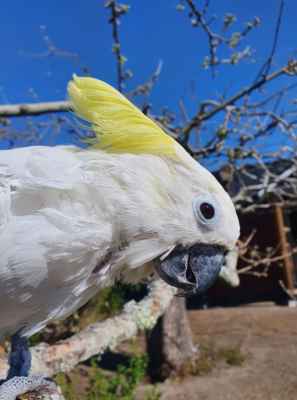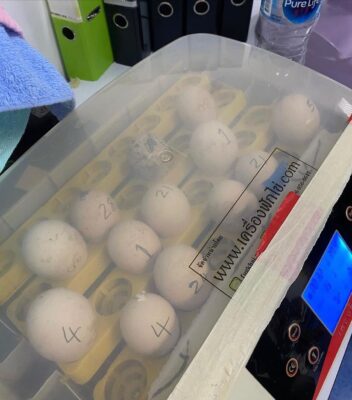Tips — not secrets — from 16 Years of Parrot Breeding
by Ben Exotic Parrot Farm
No regrets in store when I say you just walk away from something you put into it. This certainly happens when the parrot is bred. If you can’t apply love and hard work, don’t worry! The more time you spend with your birds, the better you will get to know them and observe what is needed or the particularities of certain animals.
Let’s tell the truth! Most of them do a lot of birds too. Above all, they learn through careful observation, and if you only have time to feed them and clean the aviary when necessary (or late), you need many and great details: the little things that make up everything. Small signals that determine the success or failure of reproduction. We have experienced this many times in recent years! An alliance with only a few peers achieves the best results in this area. “That’s right! Double the number of birds!” He hopes to double the number of chicks, but unless he retires and spends most of his day with the birds, he will not succeed.
I think that breeders can achieve a much better ratio of young to breeding pairs with a few pairs than with a large collection. Large collections may produce many young, but the average number of young per pair is likely to be high.

In a large collection, you rarely have time to get to know each bird and build good relationships with them. In aviaries where parrots withdraw from the viewer, owner, or feeder, this likely means they only see humans when they are fed. If you neglect to study the birds intimately, you can predict signs of health, intolerance, leg rings leading to injuries, long-term grinding, and many other signs. Not only that: what fun is it to observe birds that do not act in front of you? For me, the greatest joy of a parrot is my relationship with each parrot. Of the number of parrots, about twenty-six, I am quite satisfied, when I have kept about five hundred, or when I had eighty or ninety in my collection, that such a population was necessary for them to be large. neglected, the safety of some birds has been endangered. That’s why my most important advice is: limit the number of flights to the time you have available for each resource.
Last number two: Don’t underestimate how long it takes to keep your aviary clean and safe. If possible, set a specific time each week to check your network installations and connections. An opening or damage can cause a predator to escape or enter. Many birds also die this way. If you don’t have birds but are still thinking about purchasing an aviary, remember that it is very difficult to keep wooden aviaries in safe and sanitary condition. An aluminum birdhouse will remain in good condition for years and continue to look shiny.
Tip number three: talk to your birds. Most parrots are very social and curious and love to interact with other creatures. Talk to them! They will respond. Due to their large size, they can be mistaken for silent creatures.
Talking to them means taking the time to get to know them and observe them better. I’ve already said how important this is. By talking to them, you will build a relationship that will increase your enjoyment of raising birds. When someone says to me, “I always talk to my birds,” as if it’s something stupid or unusual, I always think, “Of course!” Why not?”
Tip number four. If you have success growing a particular strain, don’t even consider changing your method just because someone else has even more success. And if you continue to fail, don’t expect to succeed by copying the management of a successful poultry farmer. In poultry farming, the conditions in two collections are never exactly the same. Most of our methods are not quantifiable. Even if we could accurately replicate all aspects of management, the personalities and behaviors of each bird vary, as does the person caring for it. People often fail to define the real reason for their success. I attribute it to attention to detail, seen through a constantly attentive eye!
I remember a few years ago when I visited the United States, someone complained bitterly that they had copied the method I had described in an article for breeding a certain species, but this method did not work! I was surprised by his naivety!
Tip number five. Get into a routine and stick to it, especially when the time comes. Birds are creatures of habit, both in the aviary and in the wild. They also seem to have a built-in clock and know when your food is expired. This can cause anxiety or a bad mood. When I was twelve years old I started raising budgies and I got up at 6:15 in the morning to feed them before going to school. Some people are surprised when I tell them that this habit has continued throughout my life. I firmly believe that first feeding should be done as early in the day as possible, although I admit this is not essential for gregarious species. This is important for soft-bills and lorikeets, which typically ignore the previous day’s food.
Tip number six. If you have more birds than you, or if you and your partner cannot feed without help, you have too many birds. (Of course, this does not apply to commercial farms.) I remember an American friend telling me that the man he hired to feed his birds cut up fruits and vegetables and then threw them over the wall because he was too lazy to deliver them. many cages. One day my friend came across a large pile of rotten fruit. The moral of the story is: if you need to hire someone, keep a close eye on them.
Tip number seven: color is extremely important in the life of birds. Consider this when deciding what to wear with your birds. Soft colors and greens are the best. They don’t like colorful clothing, especially solid colors. This is especially true of red, which occurs naturally in flowers and the plumage of cockatoos and herons. (Veterinarians beware!)
The meaning of the octal number. Followers! This is an area that, in my opinion, the best men do not pay enough attention to. How cool is that? Don’t you just need one at the end of the aviary? Certainly not! Imaginative. Most parrots enjoy an upright posture. Imagine what it’s like to wear uncomfortable shoes every day. Mala psittacia is the equivalent of our psittaci. Satellites may fall into this category because they are old and shiny, too large, dirty, made of plastic or metal (which shouldn’t you do?), or missing altogether. I remember one place where, to my horror, all the birds were trapped with wires. The pursuers have long since disbanded or retired. This was clearly a couple who should have stopped parroting a long time ago! (Equally sad was the state of the house’s windows, which were completely destroyed by spiders. I thought I was in a horror movie!
Natural forest satellites are recommended. Given the exceptional situation, many parrots prefer surprisingly thin perches. Indeed, they like thin and elastic branches, especially willows. Nothing excites most parrots more than a new supply of freshly cut twigs. They bring both joy and work. The parrot can freely choose the size of its perches, because it is not good for its legs to always have the perches at the same circumference. The cage bars should be washed frequently; The fruit quickly makes them sticky.
It’s a lot of work to fill aviaries and cages with enough branches. Parrots spend most of the day gnawing and gnawing when they have enough freshly cut wood or berry-laden branches to cover with mulch. For some city dwellers, finding a store can be more problematic. Ask other local parrot keepers for advice, as they will be able to recommend suitable trees.
The meaning of the number nine Not for aggressive birds. Hereditary access. This leads to problems such as killing males and breeding birds with poor skin color, which is not wise for breeding.
The meaning of the number ten You will enjoy hunting much more if you know in your heart that you are doing everything you can to enrich the environment. My heart sinks when I see an aviary with a pole at each end. My aviaries turn into interesting environments. There are sturdy shrubs such as elderberries, which grow in gravel on the ground or in pots, stainless steel plates hanging from the ceiling, which make not only a soft bath, but also a softer bath, and a simple and softer bath made from an elongated bath. piece of apple branch. where everyone is connected by one bond. End Depending on how playful the bird pair is, they are also given other items to throw or chew.
Warning number eleven. Cultivate your dog side! When you see a ‘real pair’ for sale, you rightly wonder whether the rings are the right size and whether there is a DNA type certificate with the corresponding ring numbers. Otherwise they could be other ‘husbands’ of imbeciles!




